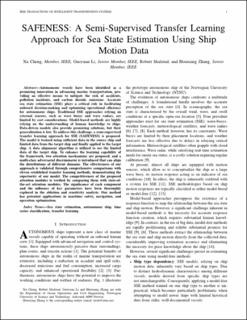| dc.contributor.author | Cheng, Xu | |
| dc.contributor.author | Li, Guoyuan | |
| dc.contributor.author | Skulstad, Robert | |
| dc.contributor.author | Zhang, Houxiang | |
| dc.date.accessioned | 2024-02-02T09:20:37Z | |
| dc.date.available | 2024-02-02T09:20:37Z | |
| dc.date.created | 2023-12-13T09:30:21Z | |
| dc.date.issued | 2023 | |
| dc.identifier.citation | IEEE transactions on intelligent transportation systems (Print). 2023, . | en_US |
| dc.identifier.issn | 1524-9050 | |
| dc.identifier.uri | https://hdl.handle.net/11250/3115197 | |
| dc.description.abstract | Autonomous vessels have been identified as a promising innovation in advancing marine transportation, providing an effective means to mitigate the risk of accidents, pollution incidents, and carbon dioxide emissions. Accurate sea state estimation (SSE) plays a critical role in facilitating onboard decision-making and optimizing operational efficiency for autonomous ships. Traditional SSE approaches relying on external sensors, such as wave buoys and wave radars, are limited by cost considerations. Model-based methods are highly relying on the understanding of human knowledge to ships. Data-driven models also provide promising solutions, but their generalization is low. To address this challenge, a semi-supervised transfer learning approach for SSE (SAFENESS) is proposed. The model is trained using sufficient data in the source ship and limited data from the target ship and finally applied to the target ship. A data alignment algorithm is utilized to use the limited data of the target ship. To enhance the learning capability of the framework, two attention mechanisms are proposed, and a multi-class adversarial discriminator is introduced that can align the distributions of different domains. The effectiveness of our approach is validated through comprehensive comparisons with eleven established transfer learning methods, demonstrating the superiority of our model. The competitiveness of the proposed attention modules is verified by comparing them with state-of-the-art attention modules. The significance of each component and the influence of key parameters have been thoroughly explored in the ablation and sensitivity analysis. Our method has potential applications in maritime safety, navigation, and operation optimization. | en_US |
| dc.language.iso | eng | en_US |
| dc.publisher | IEEE | en_US |
| dc.relation.uri | https://ieeexplore.ieee.org/document/10304562 | |
| dc.title | SAFENESS: A Semi-Supervised Transfer Learning Approach for Sea State Estimation Using Ship Motion Data | en_US |
| dc.title.alternative | SAFENESS: A Semi-Supervised Transfer Learning Approach for Sea State Estimation Using Ship Motion Data | en_US |
| dc.type | Journal article | en_US |
| dc.type | Peer reviewed | en_US |
| dc.description.version | acceptedVersion | en_US |
| dc.rights.holder | © 2023 IEEE. Personal use of this material is permitted. Permission from IEEE must be obtained for all other uses, in any current or future media, including reprinting/republishing this material for advertising or promotional purposes, creating new collective works, for resale or redistribution to servers or lists, or reuse of any copyrighted component of this work in other works | en_US |
| dc.source.pagenumber | 12 | en_US |
| dc.source.journal | IEEE transactions on intelligent transportation systems (Print) | en_US |
| dc.identifier.doi | 10.1109/TITS.2023.3326281 | |
| dc.identifier.cristin | 2212724 | |
| cristin.ispublished | true | |
| cristin.fulltext | postprint | |
| cristin.qualitycode | 1 | |
